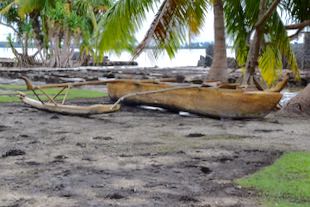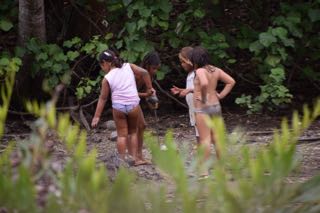24-hour visit on Huahine

Take Off
Jörgen Wennberg
Fri 6 May 2016 09:20
16.43 S 151.02 W With its inimitable laid-back lifestyle, Huahine has managed to stay “of the beaten track”. Far from the hustle and bustle of Tahiti, the nonchalant pace of the small town of Fare gives the impression that time has stopped. Huahine is situated 170 km Northwest of Tahiti. It is composed of 2 islands enclosed in a single lagoon, with a land mass of 75 km2. A bridge separates Huahine Nui from Huahine Iti at the channel connecting the bays of Maroe and Port Bourayne. It is an old island born from 3 distinct volcanic eruptions. The highest point is Mt Turi (669m) on the North island. Mt Tavahiuara in Fitii is said to look like the head of a pregnant woman lying down, which can easily be seen from the beach in Fare (Mt Turi is her knee). The Southern island peaks at 463 m on the summit of Mt Pohue Rahi. Its roughly 6400 people live an essentially rural lifestyle. We sailed over night from Mo’orea to Huahine arriving at 7 am in the morning. We do not want to arrive too early as we need the daylight to navigate into the pass of the atoll. Just as we entered the pass, our plotter turns black! Luckily we had the catamaran Two Fish that nicely lotsed us in the bay.   Our breakfast sight !   We took our dinghy into shore and hired a car for the day. We first visited the archeological sites “Marae” that traditionally were political and religious sites where important decisions for the village were taken among the politicians and religious people.       One of the main attractions of the islands are the sacred blue-eyed eels lurking in the shade of the fresh water river of Faie.   We met locals telling us to buy a can of mackerel (makrill in Swedish) to get the eels more vivid. That worked well however Jörgen had company of another one being attracted by the smell...   Note their bright blue eyes!     Where we bought the mackerel. This dog knows exactly were to find the rests.   We drove further South of the island, being taken away by the locals' daily routines along the side of the road     A stop with a beautiful view over the coral reef surrounding the island as a ring around.  At last we stopped at Relais Mahana where we had a well deserved ice-cream  At the resort they had the owner of “La maison du Pareo” teaching us how to design and paint a pareo. The pareo is the basic article of clothing for all Polynesians. This large piece of cotton fabric, hand-painted or died and dried under the sun, with colourful and decorative pattern, is used as a dress or skirt but also as shorts for men. He was    |